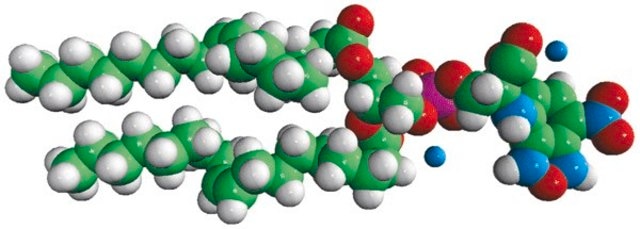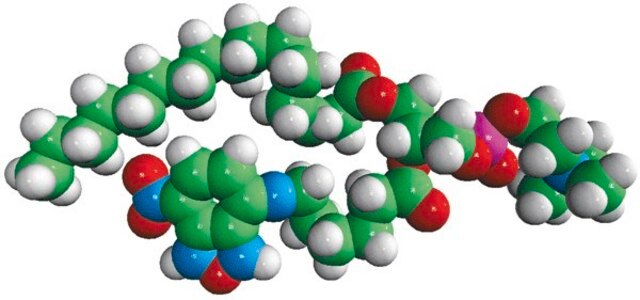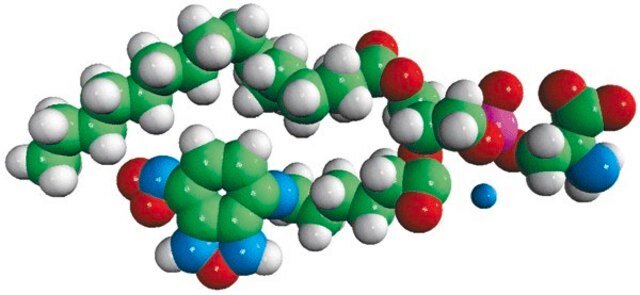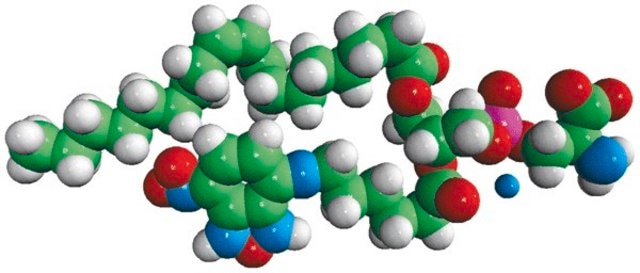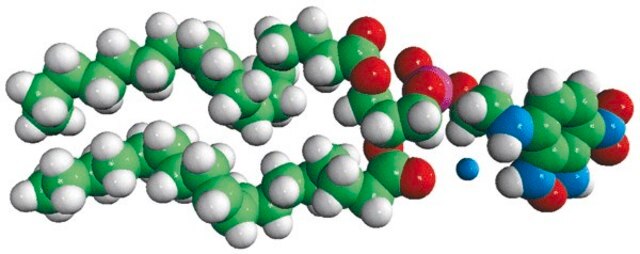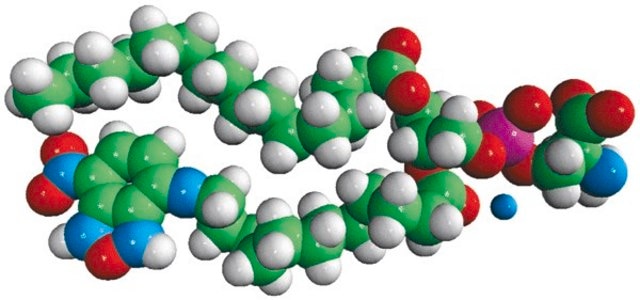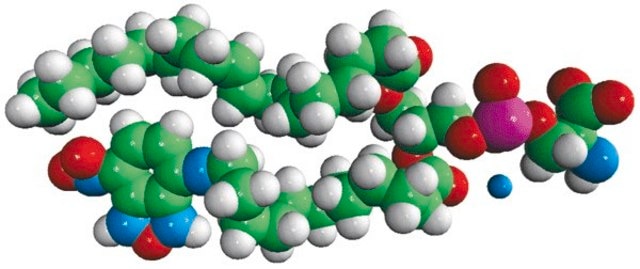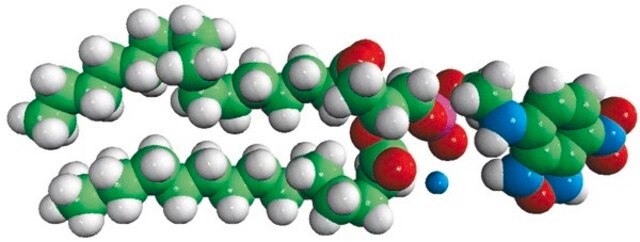810192P
Avanti
16:0-06:0 NBD PS
Avanti Polar Lipids 810192P, powder
Synonym(s):
1-palmitoyl-2-{6-[(7-nitro-2-1,3-benzoxadiazol-4-yl)amino]hexanoyl}-sn-glycero-3-phosphoserine (ammonium salt)
Sign Into View Organizational & Contract Pricing
All Photos(2)
About This Item
Empirical Formula (Hill Notation):
C34H59N6O13P
CAS Number:
Molecular Weight:
790.84
UNSPSC Code:
12352211
NACRES:
NA.25
Recommended Products
Assay
>99% (TLC)
form
powder
packaging
pkg of 1 × 1 mg (810192P-1mg)
manufacturer/tradename
Avanti Polar Lipids 810192P
shipped in
dry ice
storage temp.
−20°C
General description
Phosphatidylserine (PS) is a membrane phospholipid enriched in the cytosolic leaflet of plasma membrane. It comprises 2-10% of total phospholipids. NBD PS is a flurosently labelled phospholipid with 7-nitrobenz-2-oxa-1,3-diazol-4-yl (NBD) at the headgroup of PS.
Application
16:0-06:0 NBD PS has been used as a labelled translocase to detect ATP-dependent translocation across late Golgi membranes. It is also suitable for analysis of phospholipid scramblase 1 (PLSCR1) scrambling in proteoliposomes and to determine enzyme specificity of lipoteichoic acid synthase enzyme (LtaS).
16:0-06:0 NBD PS or 1-palmitoyl-2-{6-[(7-nitro-2-1,3-benzoxadiazol-4-yl)amino]hexanoyl}-sn-glycero-3-phosphoserine (ammonium salt) has been used in the 7-nitrobenz-2-oxa-1,3-diazol-4-yl (NBD) − phospholipase (PL) translocation assay to characterize an ATP-dependent flippase activity in yeast Golgi membranes. It may be used: to detect vesicular stomatitis virus G (VSV G) protein mediated cell-cell fusion, measure the enzyme substrate specificity of lipoteichoic acid (LTA) synthase (LtaS), in liposomes to determine the role of phospholipid scramblase 1 (PLSCR1) in phospholipid scrambling.
Biochem/physiol Actions
Phosphatidylserine (PS) is involved in the regulation of many enzymes and structural components. It serves as an essential factor in the clearance of apoptotic cells. It is associated with cognitive disability in Alzheimer′s disease.
Packaging
5 mL Amber Glass Screw Cap Vial (810192P-1mg)
Legal Information
Avanti Research is a trademark of Avanti Polar Lipids, LLC
Storage Class Code
11 - Combustible Solids
Certificates of Analysis (COA)
Search for Certificates of Analysis (COA) by entering the products Lot/Batch Number. Lot and Batch Numbers can be found on a product’s label following the words ‘Lot’ or ‘Batch’.
Already Own This Product?
Find documentation for the products that you have recently purchased in the Document Library.
An Unrecognized Function of Cholesterol: Regulating the Mechanism Controlling Membrane Phospholipid Asymmetry
Arashiki N, et al.
Biochemistry, 55(25), 3504-3504 (2016)
Measuring translocation of fluorescent lipid derivatives across yeast Golgi membranes
Natarajan P, et al.
Methods, 39(2), 163-168 (2006)
Osmotic stress adaptation in Lactobacillus casei BL23 leads tostructural changes in the cell wall polymer lipoteichoic acid
Palomino MM, et al.
Microbiology, 159(11), 2416-2426 (2013)
Mirka E Wörmann et al.
Molecular microbiology, 79(3), 566-583 (2011-01-25)
Lipoteichoic acid (LTA) is an important cell wall polymer in Gram-positive bacteria. The enzyme responsible for polyglycerolphosphate LTA synthesis is LtaS, first described in Staphylococcus aureus. Four LtaS orthologues, LtaS(BS) , YfnI, YqgS and YvgJ, are present in Bacillus subtilis.
Maria Karatsa-Dodgson et al.
Journal of bacteriology, 192(20), 5341-5349 (2010-08-17)
Lipoteichoic acid (LTA) is an important cell wall component of Gram-positive bacteria. The key enzyme responsible for polyglycerolphosphate lipoteichoic acid synthesis in the Gram-positive pathogen Staphylococcus aureus is the membrane-embedded lipoteichoic acid synthase enzyme, LtaS. It is presumed that LtaS
Our team of scientists has experience in all areas of research including Life Science, Material Science, Chemical Synthesis, Chromatography, Analytical and many others.
Contact Technical Service